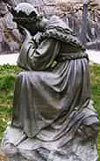Progressivism in the Church
Church Revolution in Pictures
Photo of the Week
/B078-Sta-1.jpg)
'Gay'-like poster for Seville's Holy Week
A 20-year-old young man with a feminine-like complexion poses as the Resurrected Christ to replace the traditional suffering Christ displayed in Seville for its Holy Week.For a long time the General Council of the Brotherhoods and Confraternities of Seville (Consejo General de Hermandades y Confrarias de Sevilla) have commissioned an artist to make a poster to advertise its Holy Week in Spain and abroad. Some of the past posters can be seen below third and fourth rows. This year that Council, below first row right, chose the artist Salustiano Garcia, left, for that work of art.
The final product, above, has generated a hot polemic since it was launched on January 27. Most of the Catholics who expressed their opinions were indignant for many reasons.
First, it is a highly inappropriate representation since Holy Week is a time when Catholics celebrate principally the Passion of Our Lord, and only secondarily His Resurrection. Second, it is inappropriate because the model is a 20-year-old man while Our Lord died at age 33. Third, it is inappropriate because the painting shows almost no marks of suffering. Fourth and most important, it is highly offensive because in today's social atmosphere that is constantly bombarded by homosexual propaganda, the exposition of this effeminate body looks more like an invitation to a "gay" party, last row below, than an invitation to repentance and penance in Holy Week.
Some readers saw in the contrast of the feminine body and the beard and long hair of the model a similarity to the infamous Austrian homo-star Conchita Wurst, second row.
Our opinion is that this poster is particularly offensive to the Catholic commemorations of the Passion because it was made to promote Holy Week in Seville, and Holy Week in Seville is the Holy Week par excellence, the most expressive and symbolic Holy Week in the entire Catholic world.
We agree with the comments made by the readers we listed, and we are glad to note that they tell us that there are still Catholic fibers alive in the Spanish laity, although it is sad to register that they are entirely dead in the leaders of the Brotherhoods and Confraternities.







/B078-Sta-2.jpg)




